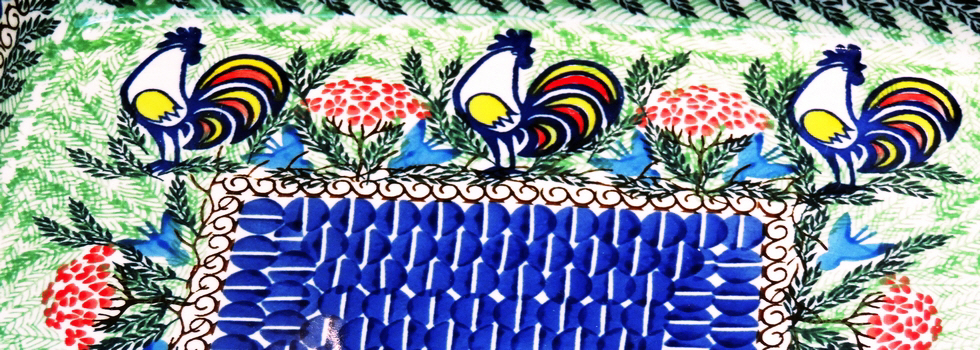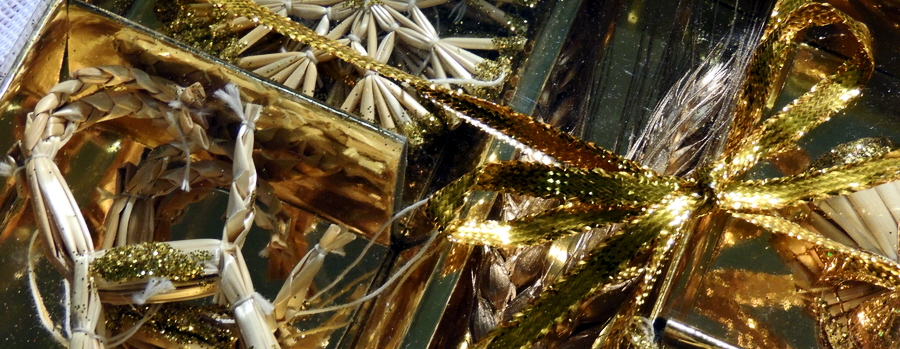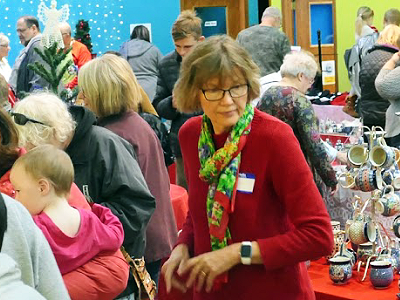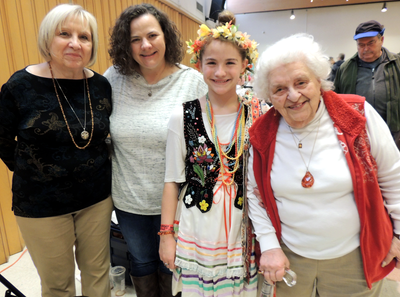


In Polish, the word szopka (plural szopki) refers to the nativity scenes (szopki bożonarodzeniowe) adorning Polish churches at Christmas time. Called also mangers, cribs or crèches, they became popular after St. Francis of Assisi created the first manger in Greccio, Italy (1223) and Franciscans brought the idea to Poland just a few years later. The Krakovian szopka emerged from this tradition in the early XIX century due to winter shortages of jobs for stone masons, brick-layers, tilers and carpenters.

Szopka krakowska belonging to the Madison's Polish Heritage Club. Constructed first in early 1980s, it was recently renovated by Gloria Welniak in consultation with several PHC members.
The resurrected szopka was first showcased at the 2018 Christmas Bazaar and PHC Wigilia. Its story is featured in the November 2018 issue of the PHC newsletter. (photo: Irena Frączek)
To make money during seasonal slowdowns, the industrious construction workers turned to building the miniature copies of church mangers and using them as portable backdrops for kolędowanie (a custom involving groups of door-to-door carolers in ritual costumes collecting donations for their singing) or staging the nativity plays (called jasełka in Polish) performed on the streets or in the houses of wealthier folks. These spectacles starred amateur actors and/or puppets, both gradually replaced with the doll-like figurines in the crèches. That’s how a new form of folk art was born taking life on its own outside of the church setting.
NOT TO BE MISSED EVENTS IN OCTOBER
All linked to the 100th Anniversary of Poland regaining independence on November 18, 1918

Screening of the historical drama THE BATTLE OF WARSAW 1920 recounting Poland's decisive victory over the Soviet invaders in one of the most critical battles in the world's history. The resounding defeat of Soviet army derailed the Soviet plan to spread communism all over Europe and preserved the sovereignty of the newly reborn Polish state (1918). The cruelty of invaders is expressively depicted on the backdrop of trials and tribulations faced by a newly married couple separated by the war. Historical figures appearing in the movie include Józef Piłsudski leading Poles to victory achieved against all odds..... check here for location and more information

In this rare opportunity to experience
Poland's musical heritage and diversity, Igor Lipinski performs music by some of the greatest Polish composers of the 19th - 21th century: Fryderyk (Frédéric) Chopin, Ignacy Jan Paderewski, Karol Szymanowski, Grażyna Bacewicz, and Paweł Mykietyn..... Polish-born Igor Lipinski is a seasoned concert pianist, university professor and occasionally, a magician (see videos to the right). Check here for location and more information.

Dr Donald Pienkos, professor emeritus of political science from UW -Milwaukee comes again to Madison to talk about events leading to Poland regaining independence in 1918. Among the main people who made Poland's rebirth happen were a soldier, a politician, a famous musician, and one of American presidents. Join us to learn more about those charismatic characters and historical events that brought Poland back on the map of Europe after 123 years of partitions... check here for location and more information
POLISH-RELATED EVENTS IN MADISON
OCTOBER 2018
October 5: Monthly PHC-Madison Breakfast
October 20: PHC sponsored screening of the historical epic "THE BATTLE OF WARSAW 1920"
Click on each line above to see details
See our calendar for more events
PHOTOS from the 2018 WILLY ST. FAIR & PARADE
FOURTH MEETING: 7pm on November 13, 2018
Topic: JAN SOBIESKI AND THE BATTLE OF VIENNA
click here for location and contact information

JAN SOBIESKI:
The King who Saved Europe
by Miltiades Varvounis
From the review by Robert Strybel: "Jan Sobieski was one of the most extraordinary and visionary monarchs of the Polish-Lithuanian Commonwealth from 1674 until his death. He was a man of letters, an artistic person, a dedicated ruler but above all the greatest soldier of his time. Popular among his subjects, he won considerable fame for his decisive victory over the Ottomans at the walls of Vienna (1683). .... Known to the Turks as the Lion of Lechistan, his greatest triumph was of course the victory of the some 80,000 Polish, Austrian and German troops under his command over a numerically superior 130,000-strong Turkish force in the September 1683 Battle of Vienna. The turning point of the battle, which had been mainly an infantry clash, came when the Polish monarch had his legendary Hussar heavy infantry charge down a hillside into the fray, striking terror in the hearts of his Turkish foes. Within hours it was all over. Ever the pious Catholic, in a letter to Pope Innocent XI Sobieski modified Julius Caesar’s well-known quote (“We came, we saw, we conquered”) into a more devout and modest: “We came, we saw, God conquered!” The pope called him “the savior of Christendom,” knowing that the victory had prevented Europe from falling under Muslim domination"
From the author's website: "... Miltiades Varvounis was born in Athens, Greece in 1980. Of Polish descent, he considers himself Graecorum et Polonorum filius (a son of Greeks and Poles). His areas of research include, among other things, "Sarmatian" civilization of the Polish-Lithuanian Commonwealth, Polish, Lithuanian, and Turkish histories. Alongside his professional activities, Miltiades Varvounis has always considered it his national duty to study Polish civilization and to promote the achievements of the Polish people to the whole world. Miltiades Varvounis lives in Athens. He also spends some time in the Polish towns of Łask and Chojnice, and in Kaunas, Lithuania. ..."

The Boy Who Wanted Wings:
Love In The Time Of War
by James Conroyd Martin
From the customer review on the Amazon website: "An absorbing historical novel throughout, this is the tale of a fascinating time, place and subject that have been given little attention. For those of us who love stories of knights, courageous underdogs, adventure and romance -- and love to learn about little known slices of history -- James Martin's novel offers a window into the rich culture of 17th century Poland and the world of the Polish Winged Hussars. The Hussars were an elite, knight class of formidable cavalrymen who took on and defeated forces much larger than theirs over the span of centuries. The story culminates in the Battle of Vienna, a real conflict in which Christendom stood on the brink of destruction. James Martin does a lovely job weaving in his characters and bringing the reader along for the ride."
ADDITIONAL BOOKS ON THE TOPIC:
The Siege of Vienna: The Last Great Trial Between Cross & Crescent by John Stoye. "...In his splendid study The Siege of Vienna, the Oxford historian John Stoye provides a detailed account of the intricate machinations between the Habsburgs and the Ottomans. Mr. Stoye's description of the siege itself is masterly. He seems to know every inch of ground, every earthwork and fortification around the Imperial City, and he follows the action meticulously..." /Eric Ormsby in The Wall Street Journal/
The Enemy at the Gate: Habsburgs, Ottomans, and the Battle for Europe by John Stoye. "...In 1683, an Ottoman army that stretched from horizon to horizon set out to seize the “Golden Apple,” as Turks referred to Vienna. The ensuing siege pitted battle-hardened Janissaries wielding seventeenth-century grenades against Habsburg armies, widely feared for their savagery... Each side was sustained by the hatred of its age-old enemy, certain that victory would be won by the grace of God.....A gripping work by a master historian, The Enemy at the Gate offers a timely examination of an epic clash of civilizations" /The GallenWilley review on the LibraryThing website/
Polish Winged Hussar 1576–1775 (Warrior) by John Stoye. This book examines the origins and development of the Polish 'Winged' Hussars. Using many years' painstaking research drawn from unpublished Polish sources, the author provides a rounded view of the training, tactics, appearance and experiences of these legendary and fascinating warriors. Most dramatic of all Hussar characteristics were the 'wings' worn on the back or on the saddle, although not all Hussars wore them, and their purpose has been fiercely debated. The Hussars terrified the Turks, Tatars, Muscovite boyars, Ukrainian Cossacks and Swedes, who did everything to avoid facing them directly in battle..." /Amazon website/
The Siege of Vienna: The Last Great Trial Between Cross & Crescent by John Stoye. "...In his splendid study The Siege of Vienna, the Oxford historian John Stoye provides a detailed account of the intricate machinations between the Habsburgs and the Ottomans. Mr. Stoye's description of the siege itself is masterly. He seems to know every inch of ground, every earthwork and fortification around the Imperial City, and he follows the action meticulously..." /Eric Ormsby in The Wall Street Journal/
















